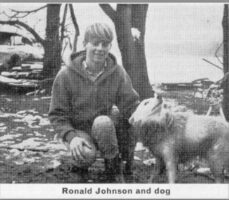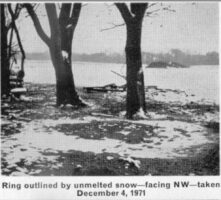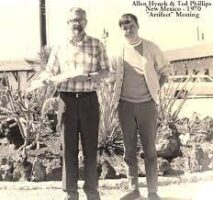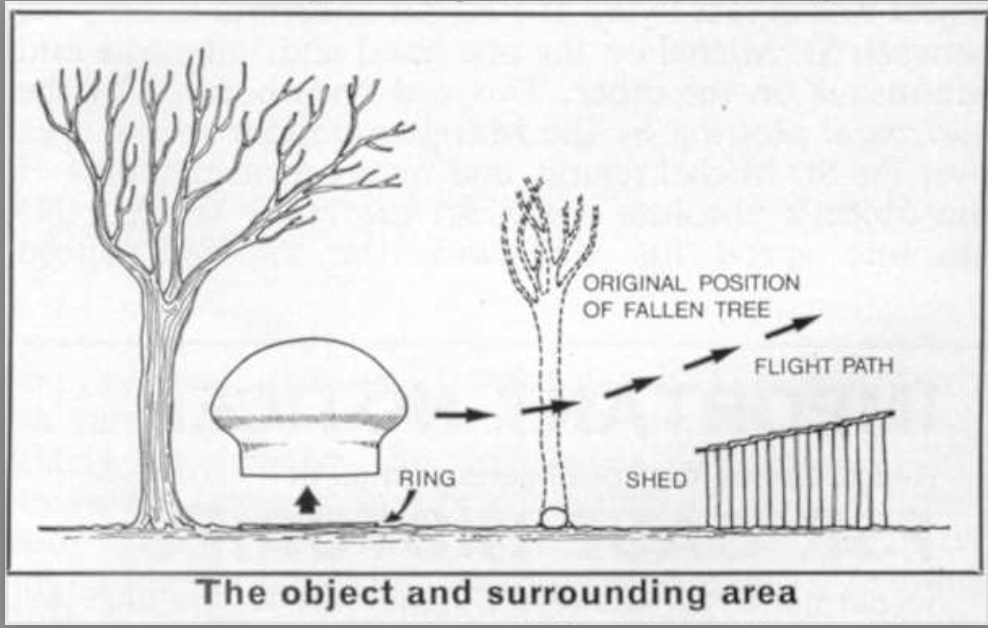by Charles Lear
 On December 17, 1969, a press release announced the closing of the Air Force’s UFO investigation, Project Blue Book. Despite this, the UFOs didn’t go away, and once the media stopped focusing on the end of Blue Book, stories of UFO sightings again made the news and graced the pages of many newspapers throughout 1970 and 1971. Toward the end of 1971, there was a case that would become a classic that was looked into by an investigator who would become well known as a specialist in UFO trace cases over the coming years.
On December 17, 1969, a press release announced the closing of the Air Force’s UFO investigation, Project Blue Book. Despite this, the UFOs didn’t go away, and once the media stopped focusing on the end of Blue Book, stories of UFO sightings again made the news and graced the pages of many newspapers throughout 1970 and 1971. Toward the end of 1971, there was a case that would become a classic that was looked into by an investigator who would become well known as a specialist in UFO trace cases over the coming years.
In the November 5, 1971 Salinas Journal out of Kansas, there is an article (page 4 of link) headlined, “Delphos Youth Surprises UFO.” It is reported in the article that 15-year-old Ronald Johnson, son of Mr. and Mrs. Dural Johnson, “was doing his evening chores in the early dark Tuesday night.” This was November 2. He was with his dog, Snowball.
He said that as he approached the back of the barn, he heard “a rumble.” He saw something bright, “like a welder,” about 50 yards away. It “whistled like a jet plane” and rose up quickly.
He got his parents out to look and they were able to see it. Ronald estimated the object to be eight feet in diameter and ten feet tall. On the ground where it had been, there was a “phosphorescent ring.” The ground was burnt, and a dead Chinese elm tree had been knocked down.
 There is a follow-up article in the November 7 edition (page 4 of link) of the same paper headlined, “The Thing That Left a Ring.” The story of the sighting by Ronald and his parents is told again with the additional detail that Ronald was putting a roof on a “small stock shed” that would provide shelter for sheep expected to give birth shortly.
There is a follow-up article in the November 7 edition (page 4 of link) of the same paper headlined, “The Thing That Left a Ring.” The story of the sighting by Ronald and his parents is told again with the additional detail that Ronald was putting a roof on a “small stock shed” that would provide shelter for sheep expected to give birth shortly.
According to the article, “law enforcement officials and personnel from the Concordia Weather Bureau office” visited the site and tried to find clues as to what the object might have been. A picture that had been taken of the ring was at the Ottowa County Sheriff’s Office. An official from that office told the paper that another sighting of “an object heading north” was reported by a Minneapolis, Kansas, resident. Ronald said that the ring had stopped glowing, but at least two trees in the area had spots that glowed at night.
 Ted Phillips looked into the case and wrote a report that was published in Flying Saucer Review Case Histories, Supplement 9, February 1971. According to Phillips, Dr. J. Allen Hynek, an astronomer who had been a scientific consultant for the Air Force throughout almost the entirety of its UFO investigation, contacted him on December 2, 1971. Phillips had become a specialist in trace evidence cases on Hynek’s advice. He was a member of the Aerial Phenomena Research Organization and one of the founders of the Midwest UFO Network, which would go on to become the Mutual UFO Network.
Ted Phillips looked into the case and wrote a report that was published in Flying Saucer Review Case Histories, Supplement 9, February 1971. According to Phillips, Dr. J. Allen Hynek, an astronomer who had been a scientific consultant for the Air Force throughout almost the entirety of its UFO investigation, contacted him on December 2, 1971. Phillips had become a specialist in trace evidence cases on Hynek’s advice. He was a member of the Aerial Phenomena Research Organization and one of the founders of the Midwest UFO Network, which would go on to become the Mutual UFO Network.
Phillips called Ottowa County Sheriff Ralph Enlow, who was one of the first to investigate the report, and told him he’d be in the area on December 4. Enlow offered to contact the Johnsons and did so.
When Phillips arrived, he was given a soil sample Enlow had taken, and the two of them went to the Johnson farm. Phillips described “the lot” as being like a bog at that point as the snow in the area was melting. Phillips talked to Ronald and his parents and they told him what they’d seen.
They went to the site and Phillips was amazed to see that the ring was visible as it was defined by the un-melted snow on top of it. After removing the snow, he found that the soil within the ring was dry in contrast to the moist soil around it. Phillips and Mr. Johnson got a soil sample from the ring, and Phillips describes it as containing a white substance that was found throughout the ring. He also describes the soil as being dry to a depth of twelve inches.
 Phillip’s report contains information not contained in the initial news accounts. Ronald Johnson said that for several days after the sighting his eyes were sore and he had headaches. Mrs. Johnson said that when she touched the glowing ring, her finger tips went numb, and when she went to rub her fingers off on her leg, the part of her leg she touched went numb as well.
Phillip’s report contains information not contained in the initial news accounts. Ronald Johnson said that for several days after the sighting his eyes were sore and he had headaches. Mrs. Johnson said that when she touched the glowing ring, her finger tips went numb, and when she went to rub her fingers off on her leg, the part of her leg she touched went numb as well.
Phillips includes a report written by Thaddia Smith, a reporter at the Delphos Republican. The Johnsons had told her their story the day after their sighting and she went to the farm, saw the ring, and took a picture. She called the Concordia Weather Bureau and the Ottowa County Sheriff’s Office.
There is also a report from Undersheriff Harlan Enlow. He wrote that he, Sheriff Ralph Enlow, and Kansas Highway Patrol Trooper Kenneth Yager went to the farm on November 3, talked to the Johnsons, observed the ring, took a soil sample of it, and took a picture of it. They also checked for radiation with a “Civil Defense Radiological Monitor” and found nothing unusual.
Phillips returned again on January 11, 1972. He spoke with Sheriff Enlow and included a written statement from Enlow in his report. Enlow wrote that the Johnsons were respected by the officers of his department and that he felt the information given by the Johnsons would be accurate to the best of their knowledge.
A letter to J. Allen Hynek at the Center for UFO Studies, dated December 9, 1977, contains the results of a chemical analysis done by Erol A. Faruk Ph.D., a research fellow at the University of Nottingham. According to Faruk, the soil contained an “organic substance” that caused it to be hydrophobic. He says that “paradoxically” the substance could be washed out of the soil with water. He describes the substance as being “an alkali metal salt of an organic acid” and speculates that its depth in the soil was due to its being introduced in “an aqueous solution.” He then compares the structure of the substance, that being “an essentially hydrophobic organic residue containing a hydrophilic carboxylate anion,” to the structure of some local anesthetics, which he says are similar.
Faruk maintained an interest in the Delphos case. In 2017, he self-published a book about the case titled, “The Compelling Evidence for UFOs. The book is based on a paper he wrote for publication in a scientific journal that was rejected. Faruk said in a 2017 interview with Express that he was told the paper dealt with “inappropriate subject matter.”
In 2021, Faruk did manage to get published by the Scientific Coalition for UAP Studies. In his paper, The Delphos CE 2 Case-A New Appraisal of the Data, he still doesn’t conclusively identify the substance but presents a “reasonable deduction” as to its chemical makeup with the formula: C14 H14 N2 O12 2- Ca 2+. He explains the luminescence of the UFO and the ring as possibly having been due to oxidation as the substance was spread over the ground in a sprayed aqueous solution.
In his conclusion, Faruk argues that while his hypothesis that a “UAP spraying an aqueous solution into the ground may read like a sci-fi fantasy,” it provides a model that fully explains the more puzzling features of the report.Delphos pdf